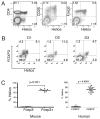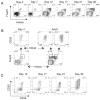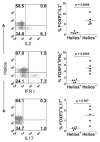Expression of Helios, an Ikaros transcription factor family member, differentiates thymic-derived from peripherally induced Foxp3+ T regulatory cells
- PMID: 20181882
- PMCID: PMC3725574
- DOI: 10.4049/jimmunol.0904028
Expression of Helios, an Ikaros transcription factor family member, differentiates thymic-derived from peripherally induced Foxp3+ T regulatory cells
Abstract
Helios, a member of the Ikaros transcription factor family, is preferentially expressed at the mRNA level by regulatory T cells (Treg cells). We evaluated Helios protein expression using a newly generated mAb and demonstrated that it is expressed in all thymocytes at the double negative 2 stage of thymic development. Although Helios was expressed by 100% of CD4(+)CD8(-)Foxp3(+) thymocytes, its expression in peripheral lymphoid tissues was restricted to a subpopulation ( approximately 70%) of Foxp3(+) T cells in mice and humans. Neither mouse nor human naive T cells induced to express Foxp3 in vitro by TCR stimulation in the presence of TGF-beta expressed Helios. Ag-specific Foxp3(+) T cells induced in vivo by Ag feeding also failed to express Helios. Collectively, these results demonstrate that Helios is potentially a specific marker of thymic-derived Treg cells and raises the possibility that a significant percentage of Foxp3(+) Treg cells are generated extrathymically.
Conflict of interest statement
The authors have no financial conflicts of interest.
Figures







Comment in
-
Comment on "Expression of Helios, an Ikaros transcription factor family member, differentiates thymic-derived from peripherally induced Foxp3+ T regulatory cells".J Immunol. 2010 Dec 15;185(12):7129; author reply 7130. doi: 10.4049/jimmunol.1090105. J Immunol. 2010. PMID: 21127313 No abstract available.
Similar articles
-
Comment on "Expression of Helios, an Ikaros transcription factor family member, differentiates thymic-derived from peripherally induced Foxp3+ T regulatory cells".J Immunol. 2010 Dec 15;185(12):7129; author reply 7130. doi: 10.4049/jimmunol.1090105. J Immunol. 2010. PMID: 21127313 No abstract available.
-
Differences in Expression Level of Helios and Neuropilin-1 Do Not Distinguish Thymus-Derived from Extrathymically-Induced CD4+Foxp3+ Regulatory T Cells.PLoS One. 2015 Oct 23;10(10):e0141161. doi: 10.1371/journal.pone.0141161. eCollection 2015. PLoS One. 2015. PMID: 26495986 Free PMC article.
-
Helios: still behind the clouds.Immunology. 2019 Nov;158(3):161-170. doi: 10.1111/imm.13115. Epub 2019 Oct 13. Immunology. 2019. PMID: 31517385 Free PMC article. Review.
-
Helios+ and Helios- cells coexist within the natural FOXP3+ T regulatory cell subset in humans.J Immunol. 2013 Mar 1;190(5):2001-8. doi: 10.4049/jimmunol.1201379. Epub 2013 Jan 28. J Immunol. 2013. PMID: 23359504
-
c-Rel: a pioneer in directing regulatory T-cell lineage commitment?Eur J Immunol. 2010 Mar;40(3):664-7. doi: 10.1002/eji.201040372. Eur J Immunol. 2010. PMID: 20162555 Review.
Cited by
-
T-cell responses after haematopoietic stem cell transplantation for aggressive relapsing-remitting multiple sclerosis.Immunology. 2013 Oct;140(2):211-9. doi: 10.1111/imm.12129. Immunology. 2013. PMID: 23721329 Free PMC article.
-
PTPN22 silencing in the NOD model indicates the type 1 diabetes-associated allele is not a loss-of-function variant.Diabetes. 2013 Mar;62(3):896-904. doi: 10.2337/db12-0929. Epub 2012 Nov 28. Diabetes. 2013. PMID: 23193190 Free PMC article.
-
Mechanisms of exTreg induction.Eur J Immunol. 2021 Aug;51(8):1956-1967. doi: 10.1002/eji.202049123. Epub 2021 May 27. Eur J Immunol. 2021. PMID: 33975379 Free PMC article. Review.
-
Activation-induced FoxP3 expression regulates cytokine production in conventional T cells stimulated with autologous dendritic cells.Clin Vaccine Immunol. 2012 Oct;19(10):1583-92. doi: 10.1128/CVI.00308-12. Epub 2012 Aug 1. Clin Vaccine Immunol. 2012. PMID: 22855393 Free PMC article.
-
Tissue Tregs.Annu Rev Immunol. 2016 May 20;34:609-33. doi: 10.1146/annurev-immunol-032712-095948. Annu Rev Immunol. 2016. PMID: 27168246 Free PMC article. Review.
References
-
- Shevach EM. Mechanisms of foxp3+ T regulatory cell-mediated suppression. Immunity. 2009;30:636–645. - PubMed
-
- Curotto de Lafaille MA, Lafaille JJ. Natural and adaptive foxp3+ regulatory T cells: more of the same or a division of labor? Immunity. 2009;30:626–635. - PubMed
-
- Bennett CL, Christie J, Ramsdell F, Brunkow ME, Ferguson PJ, Whitesell L, Kelly TE, Saulsbury FT, Chance PF, Ochs HD. The immune dysregulation, polyendocrinopathy, enteropathy, X-linked syndrome (IPEX) is caused by mutations of FOXP3. Nat Genet. 2001;27:20–21. - PubMed
-
- Wildin RS, Ramsdell F, Peake J, Faravelli F, Casanova JL, Buist N, Levy-Lahad E, Mazzella M, Goulet O, Perroni L, et al. X-linked neonatal diabetes mellitus, enteropathy and endocrinopathy syndrome is the human equivalent of mouse scurfy. Nat Genet. 2001;27:18–20. - PubMed
Publication types
MeSH terms
Substances
Grants and funding
LinkOut - more resources
Full Text Sources
Other Literature Sources
Molecular Biology Databases
Research Materials

